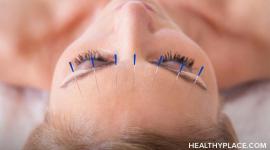Homeopathic Remedies for Mental Health Problems
A list of homeopathic remedies for treatment of psychological disorders like depression and anxiety and other health problems.
How to use homeopathic remedies
If you're suffering from a particular ailment, first take a look at Ailments. From the remedies recommended, choose one that most closely matches your symptoms.
It's best to consult a qualified homeopath to determine the remedy most suited to you for any given complaint and the best dosage. The most common over-the-counter dosages are 6C or 30C, but stronger remedies can be prescribed by practitioners.
Remedies may be taken in pill, powder, granule or liquid tincture form or as ointments or creams. The most common form is tablets or tiny pills made from a lactose base. In case of lactose intolerance, those with a sucrose base can be obtained.
continue story below
It's best to take the remedy 20 minutes before or after food. They shouldn't be handled; instead, drop directly into the mouth and allow to dissolve under the tongue.
Avoid any strong tastes or smells that could interfere with the remedy's effect. Stop consumption of coffee and mint (including mint toothpastes) and anything containing menthol or eucalyptus, for example. Store the remedy in a cool, dry, dark place away from perfumes of chemicals.
In order to get the best possible results, you should also be aware of the following points:
-
If you don't get a positive result it's possible you've chosen the wrong remedy.
-
You should decrease intake of the remedy as symptoms improve and stop it once symptoms are cleared.
-
Homeopathic remedies are safe for babies, children and expectant mothers (but get professional advice if you're pregnant).
-
Never transfer the remedies from one container to another, or recycle containers.
-
Don't touch the remedies - the heat from your body can destroy their healing properties.
-
Don't swallow with a drink.
Side effects are rare, but occasionally symptoms worsen before they get better. This is a recognized effect known as the 'healing crisis' and should last no longer than a day or so. If symptoms persist, seek professional advice.
The list of commonly used homeopathic remedies below is designed to give information about the pattern of symptoms associated with each remedy and the type of ailment for which it may be used.
Aconitum napellus
(Aco. or Aconite)
Pattern of symptoms: chills and fever, sweat and palpitations, pain, feelings of fear, anxiety, shock; symptoms begin suddenly, are acute or at an early stage and are triggered by exposure to cold, dry winds. Common uses: coughs, colds, sore throats, earache, teething, chest complaints, cystitis, eye inflammations, early stages of chickenpox, mumps or measles, bleeding in pregnancy, labor pains, anxiety, fear and shock.
Apis mellifica
(Ap. or honey bee)
Pattern of symptoms: pain, swelling, burning or stinging sensation, red face and/or tongue, feelings of restlessness or fear; symptoms get worse with touch and heat and are better when outside. Common uses: bites and stings, hives (nettle and other skin rashes), fever with dry skin, cystitis, headache, earache, sore throats, sore eyes, nappy rash, scarlet fever, irritability, tearfulness, fear of being alone.
Arnica montana
(Arn. or leopard's bane)
Pattern of symptoms: bruising, soreness, injury, shock, trauma, smelly breath, not wanting to be touched. Common uses: bruises (applied as soon as possible after injury but not on broken skin), swelling, sprains and strains, shock, trauma, joint pain, broken bones (with bruising and swelling), bleeding gums, jet lag, cough with bruised feeling from coughing, broken veins, nosebleeds due to injury, abdominal and labor pains, bad breath, fearfulness and forgetfulness after injury. Caution: don't apply to broken skin or open wounds.
Arsenicum album
(Ars. or arsenic)
Pattern of symptoms: sensitivity to cold, dry and cracked lips, burning pains, feelings of restlessness, fear and irritability, thirst, discharges; symptoms get better with heat and worse in cold or damp, after midnight and on waking. Common uses: acute colds and flu with burning nasal discharge, loose or dry cough, usually dry at night, dry and sore lips, fever and chills, burns, breathlessness, headache, indigestion, vomiting due to food poisoning, nausea, sore throat, headache, sleeplessness, diarrhea.
Belladonna
(Bell. or deadly nightshade)
Pattern of symptoms: sudden appearance and disappearance of symptoms, violent throbbing pain, dilated pupils, sweat, shock; symptoms worsened by movement and often worst around 3am and 3pm. Common uses: burning fever in children, throbbing headaches, swollen glands, intolerance to light, fever associated with chickenpox, measles, mumps or scarlet fever, sunstroke, teething and sore throats, earache, labor pains, convulsions, rage, delirium.
Bryonia alba
(Bry. or white bryony)
Pattern of symptoms: dry mouth and lips, sweat, bitter taste, sore pain, dark face and tongue, dizziness, irritability, slow onset; symptoms are worst around 9pm and after weather changes but better when lying still or on receiving firm pressure. Common uses: joint pain and swelling, broken bones with stitching pain, dry, painful cough, fever and flu with bitter taste, mastitis, measles and mumps with dislike of movement, diarrhea, dizziness, eye inflammation, depression and a feeling of wanting to be left alone.
continue story below
Cantharis vesicatoria
(Canth. or Spanish fly)
Pattern of symptoms: sudden, intense and spasmodic pain, constant desire to urinate, hot and scanty urine, severe thirst; symptoms worse before, during and after urination and after cold drinks. Common uses: cystitis, serious scalds or burns with blisters, burning sensation in throat, severe anxiety.
Causticum
(Caust. or potassium hydrate)
Pattern of symptoms: affected by weather change especially chilly and dry weather, exhaustion, blisters, loss of appetite in pregnancy; symptoms worst in the evening. Common uses: serious burns (can be used on way to hospital), bedwetting, cystitis and stress incontinence, cramp in toes and feet, hacking coughs with phlegm that's difficult to cough up, hoarseness especially in the morning, painful joints eased by warmth, restless legs, poor concentration, tearfulness over minor matters.
Chamomilla
(Cham. or German chamomile)
Pattern of symptoms: unbearable pain, feeling overemotional; symptoms get better after sweating. Common uses: teething, toothache, earache, colic, dry cough worst at night, labor pains, menstrual pains, vomiting from anger or excitement.
China officinalis
(Chin. or cinchona officinalis)
Pattern of symptoms: weakness, depletion, weariness, chilliness, feeling sluggish on waking, sensitivity to draughts; symptoms worsen at regular intervals. Common uses: anemia, nervous exhaustion, profuse sweating, flatulence and indigestion, poor appetite that returns with first mouthful, diarrhea with undigested food, headache due to mental strain, depression and apathy.
Coffea cruda
(Coff. or coffee)
Pattern of symptoms: overexcitement, oversensitivity (eg, acute sense of smell and touch); symptoms worse at night and in fresh air. Common uses: teething and toothache with shooting pain that's eased by cold drinks, labor pains with excitability and talkativeness, sleeplessness and vivid dreams.
Gelsemium sempervirens
(Gels. or yellow jasmine)
Pattern of symptoms: exhaustion, heaviness, drowsiness, lack of thirst; symptoms are gradual and worse after physical exertion but better after sweating or urination. Common uses: fevers with shivering but no sweat, flu with aching muscles and heaviness, dizziness, measles with slow onset, no thirst, drowsiness, fever and chills, diarrhea, labor pains, painful periods, anxiety during pregnancy, fear (of travel, interviews, exams, public speaking and death).
Ignatia amara
(Ign. or St Ignatius's bean)
Pattern of symptoms: contradictory symptoms, such as an empty feeling in stomach which isn't relieved by eating; grief, despair, disappointment, aggravated by stimulants such as coffee; symptoms improve with warmth. Common uses: bereavement and separation, emotional upset, depression, anxiety, irritating cough, sleeplessness due to shock, violent headaches or indigestion due to emotional upset, piles, hiccups, sore throat that's worse when not swallowing.
Lachesis
(Lach. or bushmaster snake)
Pattern of symptoms: tiredness, trembling, often left-sided complaints that move to right side, smelly breath, sweat, excitability; symptoms get worse with heat and on waking. Common uses: bites and stings, cuts and wounds that bleed and are slow to heal, sore throat or earache worst on left side, throbbing headaches worst on left side and on waking, mumps, nosebleeds, swollen glands worst on left side, piles, mental and physical exhaustion due to overwork.
Lycopodium
(Lyc. or club moss)
Pattern of symptoms: poor digestion, bloating, sweet cravings, swelling, anxiety, lack of self-confidence; symptoms worst in afternoon and evening. Common uses: indigestion, nausea, constipation, flatulence, bleeding piles, cramp, throbbing headaches, chronic catarrh, dry and tickly cough, right-sided sore throat, earache, scanty urine and cystitis, night restlessness, anxiety and mood swings.
Natrum muriaticum
(Nat-m. or sodium chloride)
Pattern of symptoms: dryness, extreme thirst, fever, chilliness, bitter taste in mouth, desire for salty foods, feelings of introversion and oversensitivity; symptoms are worst in the morning, in heat and after exertion but eased with rest. Common uses: migraine headaches, sensitive scalp, sweaty hands, colds with catarrh and sneezing, cold sores on lips often linked to suppressed emotions, constipation, diarrhea, heartburn, indigestion, nausea, cracked lips and skin, swollen hands and feet from air travel, mouth ulcers, sunstroke, dizziness, water retention, suppressed emotions.
continue story below
Nux vomica
(Nux-v. or poison nut)
Pattern of symptoms: sensitivity to cold and draughts, right-sided symptoms, workaholic, demanding and irritable; symptoms get worse after overeating or drinking, in morning and in winter but get better with heat and rest. Common uses: nausea and vomiting, morning sickness, colic, abdominal pain, indigestion, constipation, diarrhea, piles, colds, coughs and flu, stiff, aching muscles, joint pains, cramp, fainting, hangovers, headaches, labor pains, painful menses, cystitis, nosebleeds, palpitations, insomnia, dizziness.
Spongia tosta
(Spon. sea sponge)
Pattern of symptoms: anxiety, sense of suffocation, breathing difficulties, uncomfortable with tight clothing; symptoms aggravated by cold, wind, movement and overexcitement. Common uses: exhaustion, anxiety, croup with wheezing, dry cough with breathing difficulty, sore throat with hoarseness.
Staphysagria
(Stap. or palmated larkspur)
Pattern of symptoms: emotional and physical sensitivity; symptoms worse after exertion and hunger; pain, aversion to tobacco smoke, feelings of humiliation, indignation and resentment. Common uses: for injuries, cuts or wounds after surgery, medical examinations, accidents, childbirth or circumcision; cystitis, bites and stings, colic, morning or travel sickness, shingles, recurring sties, shock, anger.
Sulphur
(Sul. or flowers of sulphur)
Pattern of symptoms: smelly discharges, bad breath, hot feet, extreme thirst, untidy, averse to washing, disorganized, impatient and critical; symptoms get better with fresh air and worse after baths and changes of weather. Common uses: eczema and skin rashes (but consult a professional homeopath to ensure this is the correct remedy if the condition is severe), scaly skin and scalp, coughs and colds with dry nose and smelly catarrh, sore throat, earache, eye inflammation, fever, headaches, joint pain, restlessness and insomnia, burning or itching piles, diarrhea in early morning, indigestion, measles. Caution: don't use if there's a history of tuberculosis.
Thuja occidentalis
(Thu. or white cedar)
Pattern of symptoms: bleeding, stinging, birthmarks, deep-seated conditions. Common uses: restless sleep, headaches from stress or tiredness, chronic catarrh, tooth decay, warts, scanty periods, indigestion, urinary or gynecological infections, inflamed gums. Caution: best used with professional advice and not to be taken during pregnancy.
Please note: every effort has been made to ensure that the information and guidelines in these lists was correct at the time of launch (October 2002). However, information and recommendations change periodically in the light of new findings and best use may vary from person to person. Therefore it's always advisable to consult a qualified practitioner for advice.
back to:Alternative Medicine Home ~ Alternative Medicine Treatments
APA Reference
Staff, H.
(2008, November 27). Homeopathic Remedies for Mental Health Problems, HealthyPlace. Retrieved
on 2025, November 24 from https://www.healthyplace.com/alternative-mental-health/treatments/homeopathic-remedies-for-mental-health-problems


